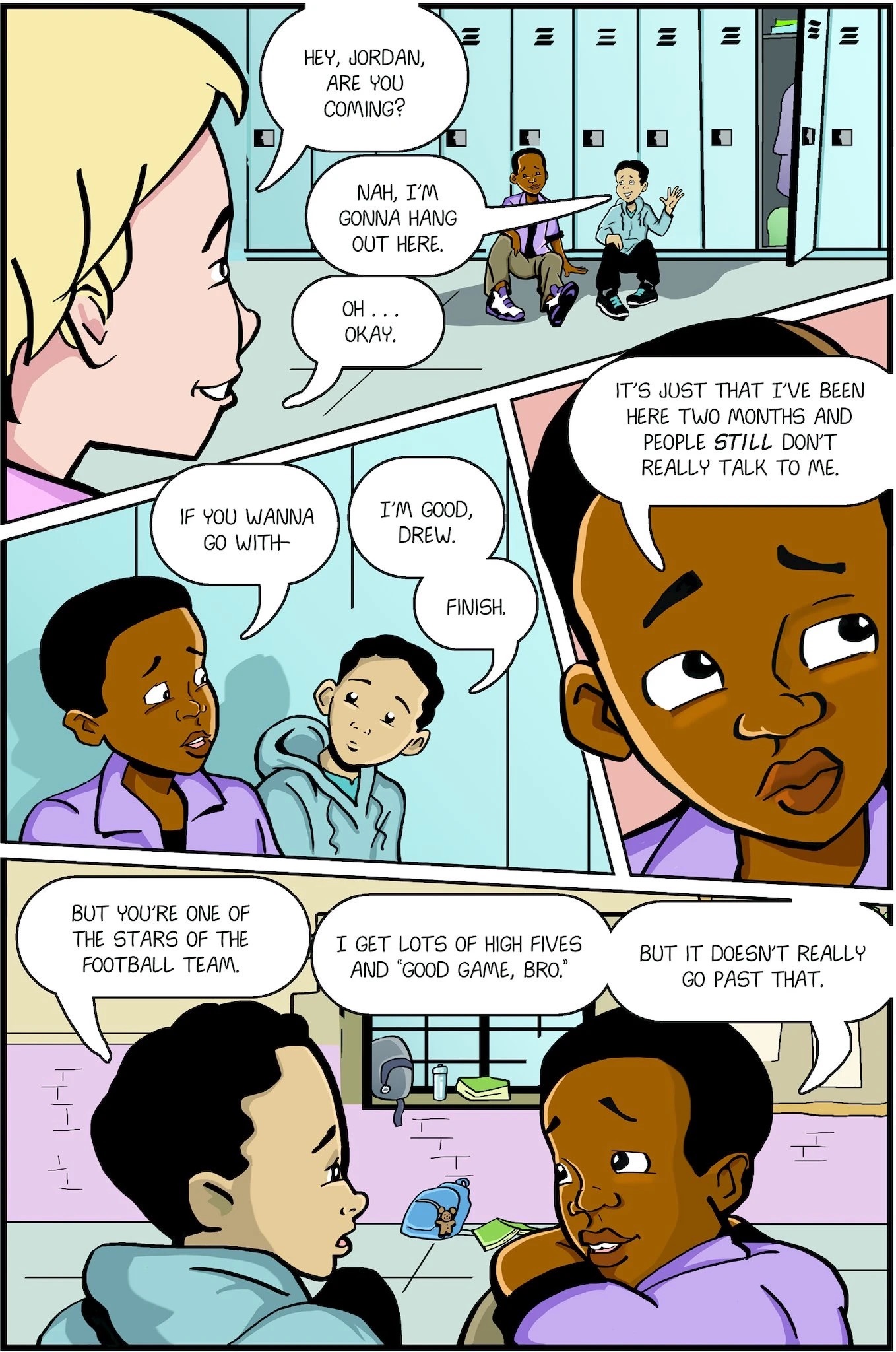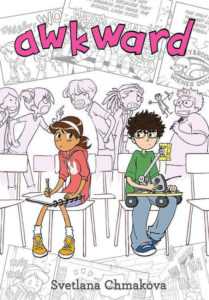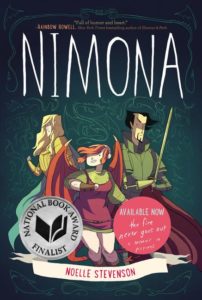Why Visual Literature Deserves Our Attention
By Jason DeHart

With the rise in popularity of authors and artists like Raina Telgemier, comic books and graphic novels seem to be an increasing source of effective teaching practice in K-12 classrooms.
Middle school is, arguably, one of the most ideal times to include these books in instruction. That’s my conclusion based on what’s available in the marketplace right now – and my years as an ELA middle school teacher.
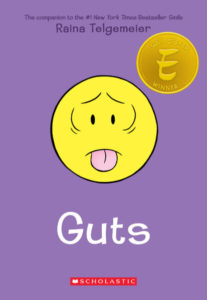
In this post, I share a few brief recommendations about using visual stories in the classroom – particularly those found in comics and graphic novels – culled from my teaching experiences and university research. I also share some book titles to get you started or extend your reach.
Embrace the Page
At first glance, it’s clear that the pages of a graphic novel work differently than do the pages of a traditional prose book. Scott McCloud, in Understanding Comics: The Invisible Art, enumerates and expands on the ways that a comics “grammar” conveys meaning.
Sometimes readers have an initial hesitation about reading visual texts if they are accustomed to prose-only passages. Comics and graphic novels offer panels, gutters, and other features that are worth noting and employing for comprehension practice.
Moreover, in a graphic novel text can appear in a nonlinear fashion – sometimes in captions, narrative boxes, and callouts, and other times in word bubbles and thought clouds emanating from the characters’ depictions. Some pages may not have words at all and may rely on the reader to pay close attention to the ways that images work.
The juxtaposition of words and pictures are part of what makes the comics medium what it is, and paneled layouts are prominent in the medium. Teachers can take note of the way that reading occurs on the page, from top left corner and then to the right of the page, and then model this for students. The eye of the reader lights on the next available word or image, or combination of the two, in a return sweep.
The pages of a graphic novel also provide a macro-view for the reader who is starting a new page and may offer a glimpse of what is ahead in the story. Teachers can consider descriptively talking with their students in think alouds about how reading occurs on the graphic novel page.
Pause Now and Then
Without attending to the ways that both words and pictures work in visual texts, a reader may finish a graphic novel too quickly, failing to capture the entirety of what the book has to offer. While the reading may be fast, the comprehension and lingering effects of the reading will have been lost. Even as an experienced graphic novel reader, I sometimes experience this myself.
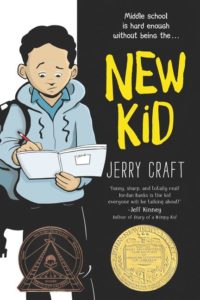
The most meaningful experience with these texts comes in a full appreciation of everything that the authors and artists offer. This arrangement of modes, or ways of sharing meaning, can be useful for classroom dialogue and close analysis.
Teaching reading is an active process, and it is important to attend to every mode when reading a graphic novel. Educators can emphasize pausing on key moments in the text and taking stock of what is presented on the page, just as one might pause the presentation of a film to highlight the composition of a key scene.
Recognize the Potential
Too often graphic novels are seen as dross to be ignored or put on a side shelf in favor of literary gold found in other places. If only more of my teachers had seized on my love of the comics medium and expressed the value of these books.
This is not to say that I wish every reading experience in my school life had been graphic novel-based. I shudder to think of reading picture and text-oriented texts in all of my middle school classes, and resist the idea that all content be rendered as a comic, or that comics should always be “schoolified”.
Yet I tried to make room for the graphic novel in my middle school classroom and continue to do so now that I teach teachers. Part of this is to foster an appreciation and love for the books in and of themselves, which I feel is an important aspect of being a reading teacher. When time came for my middle grades students to choose books to read, graphic novels were always readily available (even if I had to buy another copy of a book because it had not yet been returned).
Moreover, the popularity of the characters found in the medium, often in the superhero genre, provide an opportunity to find out more about what students find engaging. The potential for conversation about what students enjoy in their home literacy practices lines up nicely with finding spaces in the curriculum to honor what students enjoy – and learn from our students at the same time.
My Suggestion: Read Widely (Always)
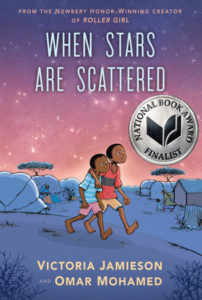
In addition to the idea of including comics and graphic novels, a final suggestion I might offer is to consider the wide range of work that authors do in these books, including memoir and representation. Graphic novels and comics are not simply superhero stories. Visual literature has proven to be a space for exploring issues of identity, aspects of personhood, and even historical moments.
For a beginning look at a middle school graphic novel curriculum, please consider what authors and artists have done in the books New Kid by Jerry Craft, When Stars Are Scattered by Victoria Jamieson and Omar Mohamed, and Guts by Raina Telgemeir. These titles are merely the tip of a much more complex and layered stack of visual (and literary) works.
Other Recommended Titles to Explore
A growing of number of graphic novels are ideal for grades 4-6 and 7-9. Below is a brief list of some that come highly recommended.
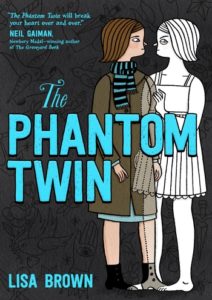
While some of the emotional content of this graphic novel may skew the readership toward the older end of the middle level age bracket, Brown’s story of conjoined twins and loss is heartfelt and powerful.
The Lowriders Series by Cathy Camper and Raul the Third
Ideal for learning language from Spanish to English, and vice versa, the Lowriders series is uniquely designed and could be applied with impact across grade levels.
Sitting at the older end of this spectrum, Svetlana Chmakova’s book captures the essence of middle school – I also recommend Chmakova’s book Diary (another in the Berrybrook MS series) for clear connections to composition instruction.
Real Friends by Shannon Hale
Shannon Hale weaves personal story into a two-part graphic novel that is ideal for grades 4-6, but which older readers can enjoy as well.
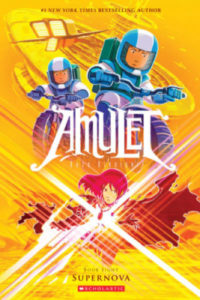
Also ideal for grades 4-6, but ageless, Kazu Kibuishi’s Amulet series is fantastic in the best sense of the word, both in artwork and storytelling.
The Witch Boy by Molly Knox Ostertag
Speaking of fantasy, Molly Knox Ostertag has crafted a series that is wonderful for discussing gender roles and expectations, albeit through a world that is both like and unlike our own.
This upper-middle book is quite simply one that I have a crush on. Noelle Stevenson brings elements of fantasy and science fiction to bear on a story that explores tropes and gender in humorous and insightful ways.
Robot Dreams by Sara Varon
Sara Varon has a range of picture books and early reader graphic novels, but Robot Dreams is particularly fascinating as a wordless graphic novel that is also ageless.
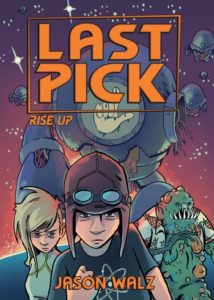
Jason Walz packs powerful messaging and imagery into The Last Pick series, and explores diverse abilities through a science fiction storyline.
Stargazing by Jen Wang
Jen Wang’s Stargazing explores empathy, culture, and identity in an inviting visual form that could be readily embraced by readers at both ends of the middle grades range.
Dr. Jason D. DeHart taught 8th grade language arts for eight years in Cleveland, Tennessee before becoming an assistant professor of reading education at Appalachian State University. After some years teaching preservice teachers, Jason returned to his “first love” and now teaches ninth graders in western North Carolina.
Jason continues to pursue his research interests include multimodal literacy, film and graphic novels, and literacy instruction with adolescents. His work has appeared in SIGNAL Journal, English Journal, and The Social Studies and here at MiddleWeb. (Updated 2024)

